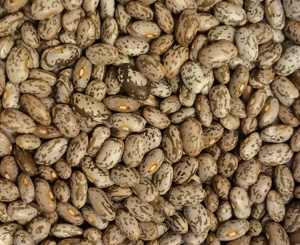5585 Guilford Road • Madison, WI 53711-5801 • 608-273-8080 • Fax 608-273-2021
www.agronomy.org
Twitter | Facebook
NEWS RELEASE
Contact: Hanna Jeske, Associate Director of Marketing and Brand Strategy, 608-268-3972, hjeske@sciencesocieties.org
Could “The Martian’s” scientist survive on potatoes alone?
September 29, 2015—In the movie “The Martian,” the main character, astronaut Mark Watney (played by Matt Damon), is stranded on Mars and must rely on his own super-science knowledge to survive. Because the crew had packed some potatoes for a Thanksgiving celebration, Watney creates a lab “garden” and is able to survive off the potatoes—after calculating how many calories he would need to survive until a rescue mission could arrive.

Pinto beans provide protein, fiber and other essential minerals.
According to plant scientists from the Crop Science Society of America (CSSA), growing potatoes in a lab situation was a very good idea, but bringing along just a few ounces of bean seeds – called Pulses – on the mission would be a better plan to start any emergency garden. “Pulses” is the broad category of edible beans that are a great source of protein and essential minerals. Pinto beans, chickpeas and peas are all examples of Pulses.
“Nutritional diversity is key for survival,” says Roch Gaussoin, a professor at University of Nebraska. Watney calculates he may need to live for four years before rescue.
“Spuds are great for calories but it’s hard to beat Pulses for nutritional quality,” says Gaussoin. “Both plants would be easy to carry into space and would require minimal space to grow when compared to many other crops. They are also adaptable to controlled environment production, versus being in the field.” Gaussoin is the current president of CSSA.
“Pinto beans would be the perfect nutritional partner with the movie's potatoes,” says Janice Rueda, a scientist with ADM Edible Bean Specialties. “They're high in both protein and fiber, as well as many important nutrients like potassium, magnesium and iron.”
In addition, “pinto beans would also have a positive impact on the agricultural production in a challenging environment like Mars. Like all Pulse crops, beans fix nitrogen into the soil and require very little water to grow - especially when compared to other protein sources.”
If this sounds a bit too “Jack in the Beanstalk,” consider that every part of the bean plant is edible. According to Mike Grusak, a research plant physiologist with the USDA-ARS and a professor at Baylor College of Medicine, “besides the protein, fiber, and minerals in the seeds, the leaves of bean plants are also edible. The leaves are a source of several essential vitamins, fatty acids, and antioxidants. The antioxidants are important for life under the higher radiation load on Mars, relative to Earth. Even bean pods are edible too, and another source of these nutrients and phytochemicals.” Grusak is president-elect of CSSA.
The UN declared 2016 as the International Year of Pulses (IYP) to bring attention to this important category of food crops. Crop Science Society will begin their celebration of IYP in late December 2015, with more information to follow.